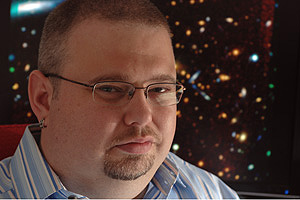Astronomy professor observes opportunity to teach his class from Andes mountaintop
By Steve KoppesNews Office
 Michael Gladders Photos by Dan Dry |
|
Michael Gladders presented two lectures to his “Astronomy and Astrophysics of Stars” class last year from a mountaintop in the Andes Mountains of South America.
Gladders had to be at the Las Campanas Observatory in the Andes to test an instrument for the twin 6.5-meter Magellan Telescopes in October 2007, so he connected with his 64 students back on campus via an Internet audio-video connection.
“I looked upon it as an opportunity to bring the class into something at a level where normally they’d never have that experience,” said Gladders, Assistant Professor in Astronomy & Astrophysics and the College.
Competition is keen among astronomers for viewing time on telescopes at major observatories like Las Campanas in Chile. The applicants fortunate enough to receive time usually accept whatever dates they are offered.
“There’s not a lot of flexibility,” Gladders said.
Gladders began working on the instrument he calls the “image slicer” three years ago, while he served as a postdoctoral fellow at Carnegie Observatories. But his colleagues refer to it as GISMO—the Gladders Image-Slicing Multi-Slit Option. “The design was entirely Mike’s,” said Alan Dressler of the Carnegie Observatories, who coined the device’s name.
GISMO connects the Magellan Telescopes to a large spectrograph that collects light at specific wavelengths. Dressler led the team that constructed the spectrograph, which can simultaneously obtain data from 300 to 400 galaxies.
Gladders will use GISMO, once fully operational, to study the evolution of galaxy clusters, a topic also of interest to many of his Chicago colleagues, who study them with the South Pole Telescope.
“In normal application, the spectra of many galaxies would overlap, so only a fraction of the targets can be done at once,” Dressler explained. “GISMO solves that problem. As far as I know, there is nothing like GISMO on any other telescope spectrograph. It’s a novel and powerful piece of instrumentation.”
 | |
When astronomers view the sky with large telescopes like the Magellans, they see many closely packed stars and galaxies. “You often want to take spectra of lots of objects that are close to each other on the plane of the sky,” Gladders said.
“One of the fundamental limitations of a typical spectrograph is that when you disperse light from one object, it occupies a big piece of the available detector space in your spectrograph.” When the spectrograph tries to record images from two adjacent objects, they interfere with each other.
“This instrument gets around that by chopping up the image that comes into the instrument into a bunch of discrete pieces that are then spread out and fed back into the spectrograph,” Gladders said.
Gladders spent a week in October 2007 at Las Campanas to commission GISMO. This meant missing three sessions of his Astronomy and Astrophysics of Stars class. During one session, he arranged to have a midterm exam administered. “The other two lectures I actually did teach from the mountain,” he said.
Not fully trusting his iChat Internet connection from such a remote location, Gladders arranged to have one of his colleagues back him up in the classroom in case of problems. He completed his first lecture with only a couple of brief technical interruptions. During that lecture, he described Las Campanas and what he was doing there, then returned to the course material he would have normally presented.
Technical problems prevented Gladders from lecturing to his class via iChat during the next session. Nevertheless, he had gone to Las Campanas equipped with a high-definition digital video camera. After his students viewed the video he had prepared and sent to campus earlier, Peter Vandervoort, Professor Emeritus in Astronomy & Astrophysics and the College, stepped in to complete the planned lesson.
The video consisted of walking and driving tours of the summit. Gladders also produced a time-lapse sequence of one of the Magellan Telescopes in action.
“I set up the video camera and just let it run at sunset as the sky was darkening,” he said. “The dome opened up and started to move around. A Harvard astronomer was picking up the first few bright targets of the night as the sun was setting.”
Observatory engineers happened to be removing a massive 64-megapixel digital camera from the large spectrograph, so Gladders got up on the platform with them to film the process. His students had learned how astronomers incorporate such instruments into their work the previous week in a laboratory exercise on spectroscopy. He pointed out that the equipment his students used in the lab was an inexpensive version of what astronomers use on the Magellan Telescopes.
“It’s like the difference between your little runabout car in the city and a Lamborghini owned by a billionaire, but the fundamental pieces are the same,” Gladders said.
As for GISMO, the instrument is 90 percent commissioned, according to Dressler. “GISMO will be available to all Magellan users in the next ‘semester,’ which begins in July ’08,” Dressler said.
![[Chronicle]](/images/sidebar_header_oct06.gif)